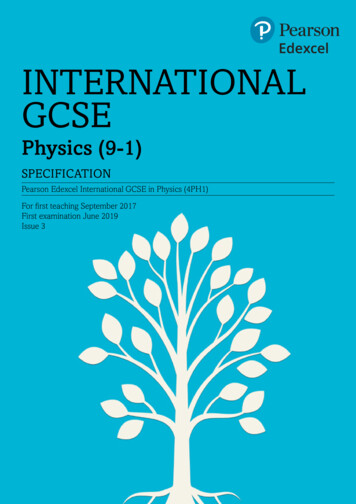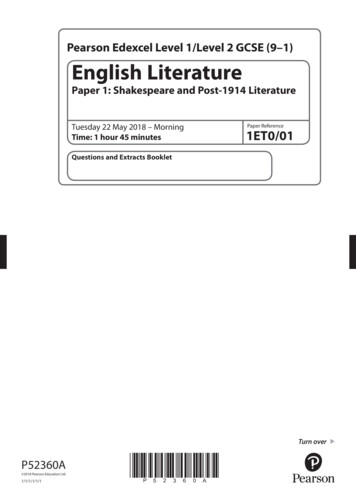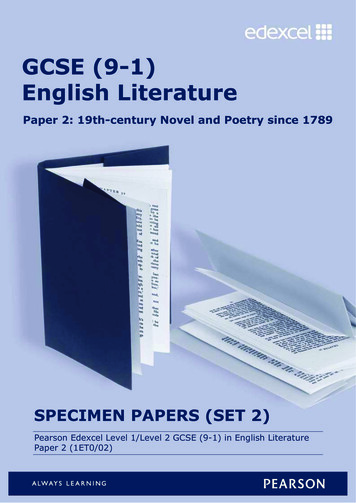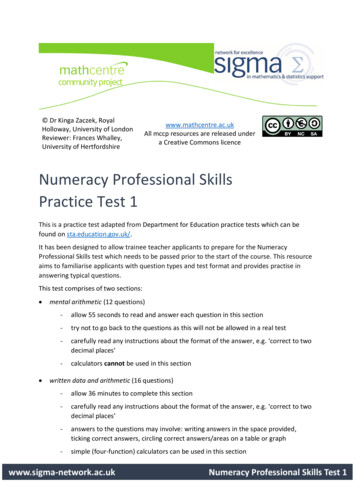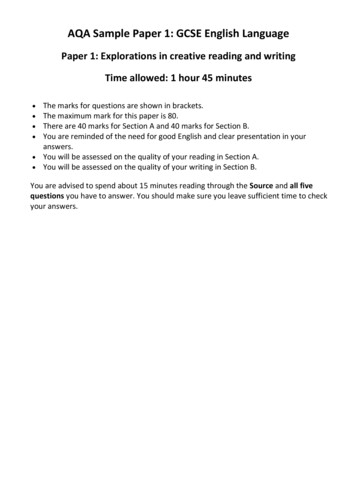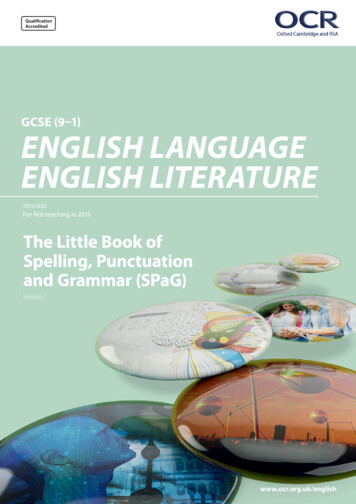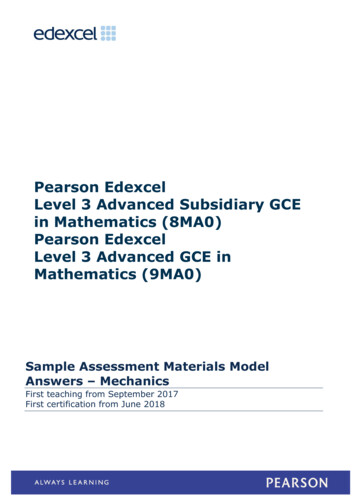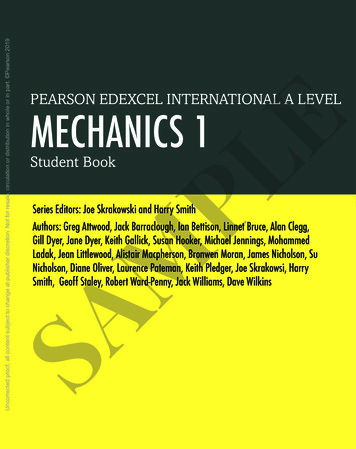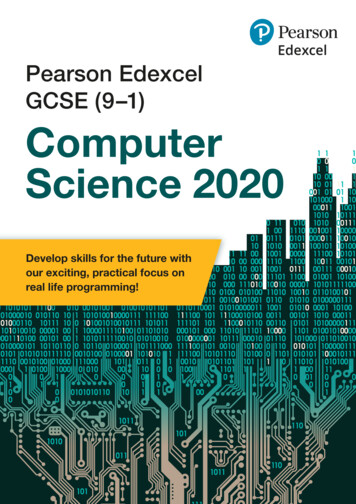
Transcription
Pearson EdexcelGCSE (9–1)ComputerScience 2020Develop skills for the future withour exciting, practical focus onreal life programming!
Pearson Edexcel GCSE (9–1)Computer ScienceThis brochure will guide you through our Pearson EdexcelGCSE (9-1) Computer Science qualification from 2020. Asboth an awarding body and a publisher, we’ll outline how ourspecification will inspire and engage your students, addresschanges to the qualification and also showcase the high qualitysupport you can expect.Our up-to-date qualification reflects the fast-changing world of ComputerScience - with innovative, future looking onscreen practical assessments toensure all students develop the computational skills they need for an excitingfuture beyond the classroom.Our qualification:has up-to-date, practical on screen assessments, engaging andaccessible for everyone.page 4features rich, future-facing, engaging content .page 6unbeatable and expert support every step of the way.page 8Our Computer Science GCSE will see paper 2 takenonscreen, a practical onscreen assessment reflectingreal-life programming in the modern world.2
Teaching ComputerScience for the futureIt’s shaped by you, for your students. That is why we’ve developed our GCSEComputer Science 2020 in collaboration with teachers and the computer sciencecommunity, to create an engaging qualification that equips students with theknowledge and practical skills to thrive in the fast-changing world of Computer Science.The future of Computer Science is here. Which is why, our qualification, the firstof its kind, provides a practical approach to developing computational skills. Thisincludes innovative, practical onscreen assessment to ensure all students develop thecomputational skills they need for an exciting digital future beyond the classroom.The practical onscreen assessment approach will prepare students wellfor eventual employment because it gives an opportunity for the learnerto be assessed on writing, testing, and refining programs in an IDE usingPython 3. Being given two hours to complete a task also relates well tothe real life time constraints experienced by many Computer Scientists.Matt Hogan, Learning Manger (Secondary) at Raspberry PiCan I thank/congratulate you on all producing three full sets of spec papersin addition to the public exemplar assessmment questions - that is reallyfantastic effort and makes such a difference when teaching a new spec. Thefact that we can engage with this level of feedback/discussion in advance ofthe first set of public assessment is testament to the superb resourcing thathas gone into making this exciting practical launch a success!Paul Baker, Head of Computing & Digital Strategy, The Perse School3
Assessment OverviewPaper 1Principles of Computer SciencePaper code: 1CP2/0175 marksWritten examination: 1 hour 30 minutes50% of the qualificationContent overviewThis paper will assess Topics 1 to 5. Computational thinking- understanding of whatalgorithms are, what they areused for and how they work;ability to follow, amend andwrite algorithms; ability toconstruct truth tables. Data - understanding ofbinary, data representation,data storage and compression. Computers - understanding ofhardware and software components ofcomputer systems and characteristics ofprogramming languages. Networks - understanding of computernetworks and network security. Issues and impact - awarenessof emerging trends in computingtechnologies, and the impact ofcomputing on individuals, society and theenvironment, including ethical, legal andownership issues.Assessment overviewThis paper consists of five compulsory questions, each one focused on one ofthe topic areas. The questions consist of multiple-choice, short-, medium- andextended-open-response, tabular and diagrammatic items.4
Paper 2Application of Computational ThinkingPaper code: 1CP2/0275 marksPractical onscreen examination: 2 hours50% of the qualificationContent overviewThis paper will assess Topic 6: Problem solving with programming.The main focus of this paper is: understanding what algorithms are,what they are used for and howthey work in relation to creatingprograms understanding how to decompose andanalyse problems ability to read, write, refine and evaluateprograms.Assessment overviewThis paper is practical in nature and requires students to design, write, test andrefine programs in order to solve problems.Students will complete this assessment onscreen using their IntegratedDevelopment Environment (IDE) of choice.They will be provided with: coding filesa hard copy of the question paper Programming Language Subset (PLS)– as an insert in the question paperand an electronic versionStudents should then answer the six compulsory questions onscreen using Python 3.5
New onscreen assessmentOur approach of assessing programming practically via our new onscreen assessmentallows schools to choose which Integrated Development Environment (IDE) touse. Students are then able to complete activities using their IDE of choice, so they’reprogramming in a familiar environment - without the need for internet access.Our assessments are designed with an underpinning pedagogical approach derivedfrom NCCE Hubs, and ensure real-world programming skills are assessed via a realistic,practical and engaging assessment experience.We’ve chosen python as a vehicle to facilitate the teaching, learning and assessment forall students to get the best possible experience.6
Any questionsabout how this will workin practice?Please take a look at our onlineFAQ document or get in touch.quals.pearson.com/ComputerScienceGuide7
Clear and simple structureOur new Pearson Edexcel GCSE (9-1) Computer Science qualification has awritten and a practical element. This balance provides students with a roundedexperience of computer science in comparison with a traditional paper basedexam that relies on students reading and writing pseudocode. Our new onscreenassessment will give them a more practical and engaging assessment experiencethat can be transferred into real world skills. kantver/123RF8
Our qualification:Has a straightforward structure. There are six comprehensive topic areas,assessed through two externally-examined papers.The written paper focuses on:computational thinkingdatacomputersnetworksthe impact and issues ofcomputing in the world today.The practical onscreenassessment focuses on:The ability to analyseand solve problems bydesigning, writing testingand refining programs ina real world setting.Has equally weighted papers. The balance of theory and practicalassessment are equally weighted, with a total assessment time of 3hrs 30 minsand a total of 150 marks (75 marks per paper).Has a reduced number of command words. This will help students to betterunderstand how they should respond to each question. We have identifiedspecific command words for each paper and we won’t stray from these.Provides a clear and easily applied mark scheme outlining exactly whatstudents need to evidence.Paper 2 doesn’t require an internet connection. The data files,Programming Language Subset (PLS) and the question paper can bedownloaded on the morning of the exam. We have at least three channelsprepped and ready to go to ensure that this works smoothly:secure download from our websitesecure download via Edexcel Online;and, as a final resort the question paper delivery team are ready to securefile transfer on request.9
Unbeatable and expertsupport every step ofthe wayOn our website, you'll find a range of teaching and learning material to help youprepare for this new qualification and assessment style, including:three sets of samples papers that will be ready long before the first liveassessment, as we know how important it is that your students are preparedand familiar with the assessments before they sit their exama Getting Started Guide, providing additional guidance that clarifies whatneeds to be covered for each topic areaa new interactive scheme of worklesson plans, activities and solutionsa series of short videos that talk about the paper 2 assessment talking aboutthe logistics of the exam and going through each question and mark schemein details.Mocks Marking Training event.Turn over to discover more about our free support forplanning, delivering, teaching and assessing PearsonEdexcel GCSE (9-1) Computer Science.10
kantver/123RF11
Learn more aboutour The Interactive Scheme of WorkSpecially designed resources aligned to the specification,bringing Computer Science to life with real-world examples,and providing support for the new practical on-screen assessment.Our brand new interactive scheme of work (iSOW) supports the new practicalapproach and assessment requirements of GCSE Computer Science and:recommends a practical teaching route and can be customised as muchor as little as you want to support your level of specialismwill save you time and effort in identifying the best resources, where bestto use them in the classroom and how to get the most impact from themincludes:lesson plans, practical activities and solutions that have been written for thespecificationa wealth of resources to support teaching Python that have beendesigned for you and for your studentsspecific links to high quality resources from leading pedagogical and industryorganisations in Computer Science that have been chosen to support ournew qualification’s practical approach including NCCE’s resource PG Online,Microsoft’s MakeCode, Craig'n'Dave's YouTube resources and many more.The Student BookPearson Edexcel GCSE (9-1) Computer ScienceSeries Editor: Lorem ipsomLorem ipsum dolor sit amet, consectetur adipiscing elit, sed doeiusmod tempor incididunt ut labore et dolore magna aliqua. Vitaesapien pellentesque habitant morbi tristique senectus. Malesuadafames ac turpis egestas sed tempus urna et pharetra. Commodo quisimperdiet massa tincidunt nunc pulvinar. Sollicitudin nibh sit ametcommodo nulla facilisi nullam vehicula ipsum. Faucibus et molestieac feugiat sed lectus vestibulum mattis. Diam in arcu cursus euismodquis viverra nibh. Pharetra magna ac placerat vestibulum lectusmauris ultrices. Pellentesque sit amet porttitor eget dolor morbi nonarcu risus. Aliquam faucibus purus in massa tempor nec feugiat nislpretium. Gravida quis blandit turpis cursus in hac habitasse. Vel risuscommodo viverra maecenas accumsan lacus vel facilisis. Id faucibusnisl tincidunt eget nullam non nisi est sit. Molestie a iaculis at eratpellentesque adipiscing commodo elit. Vivamus at augue eget arcudictum varius duis at consectetur.Pulvinar mattis nunc sed blandit libero volutpat. Nunc sed blanditlibero volutpat sed. Suspendisse faucibus interdum posuere loremipsum dolor. Elementum sagittis vitae et leo duis. Egestas conguequisque egestas diam in arcu. Nascetur ridiculus mus mauris vitaeultricies leo integer. Lorem donec massa sapien faucibus et molestie.Id leo in vitae turpis massa sed. Vitae auctor eu augue ut lectus arcu.Ridiculus mus mauris vitae ultricies leo integer malesuada nunc vel.Metus vulputate eu scelerisque felis imperdiet proin fermentum leovel. Varius duis at consectetur lorem donec massa sapien faucibus et.ActiveLearn Digital ServiceOur online ActiveLearn Digital Service,powered by ActiveTeach provides a wealthof teaching, planning and assessmentsupport.ISBN: 9781292120607Revise An ActiveBook (eBook) version of theStudent Book is available for schools andcolleges, with multiple user licenses to provideflexibility in the way you teach.The front cover shows Lorem ipsum dolor sit amet, consectetur adipiscing elit,sed do eiusmod tempor incididunt ut labore et dolore magna aliqua. Vitaesapien pellentesque habitant morbi tristique senectus.Pearson Edexcel GCSE (9-1) Computer Science 2.0Our brand new Pearson Edexcel GCSE (9–1)Computer Science Student Book follows thepractical teaching and learning approach of theinteractive scheme of work and provides all of thecontent, activities and exam support that you need todeliver the 92131580Prepare for GCSE from Year 7with Exploring SciencePearson Edexcel GCSE (9-1)www.pearsonschools.co.uk/KS3ESComputer ScienceSeries Editor: Anne Weidmann Authors: Cynthia Selby Anne Weidmann David Take a look and download sample copies onlinepearsonschools.co.uk/CSResourcesCVR GCSE CS SB CVR v3.indd 11201/04/2020 15:19
Case studies ofComputer Sciencein Action help tomake the contentmore relevant andinspiring to all ofyour students.Only the essentialcontent has beenincluded and thematerial has beensimplified to make it asaccessible as possible.Computational thinkingPacked with practicalactivities to support thepractical approach of theEdexcel specification.Computational thinkingPRIMM ActivityComputer Science in action: Chess algorithmsThis activity uses the code shown here. Use it for each of the steps shown.OThere are steps to follow that will help produce programs that execute ona computer. Depending on the complexity of the original problem, some ofthese may be omitted, but for most problems, these steps show a sensibleapproach.PPRun:Implement – translate the description of the algorithm to a programminglanguage.Load the code into your coding environment and run it.Evaluate – make judgements about the solution based on the originalrequirements of the problem and consider changes related to efficiency.Investigate:TDid it do what you thought it would do? Did the output match yourprediction? If not, how did it differ?TDebug and test – using tools, execute, find errors, fix errors and testdifferent inputs.Remove the line ‘b 22’. Run the code. Carefully read the error message.What is the message trying to tell you? Put the line back in.Example of a simple algorithmChange the calculation to move the ‘(1/2)’ between the ‘b’ and ‘h’.Run the code. What does that tell you about the use of brackets?What does that tell you about the order of arithmetic operators?FHere is an example of a simple algorithm. It sets two numbers, calculatesthe total by adding them together, and then displays the total on the screen.This algorithm does not need the user to type in any numbers.Three different versions of this algorithm are shown: a written description;a flowchart; and program code.FModify:AASRRWhat do you think the code will do? What output do you think it willproduce?Design – develop a solution to the problem and express the solution in awritten description and/or a flowchart.Written descriptionWorked exampleBelow is an algorithm for adding two numbers.RR# ----------------------------------------------# Main program# ----------------------------------------------a (1/2) * b * hprint ("Area is", a)Predict:Analyse – understand the problem that needs to be solved and how todetermine success.Set the first number to 11.Calculate total by adding first and second numbers.Output total.DSet the second number to Global ----- 22 44 0FIn addition to flowcharts and written descriptions, algorithms can also beexpressed in program code. Both flowcharts and written descriptions canbe translated into programming languages.OProgram code: theimplementation of an algorithm,in a human-readable form, thatcan be translated to a form thatcan be executed on a computer.FProgram codeKey terms###bhaOS123456789101112OAlgorithms for playing chess are used widely. After four moves by each opponent, there areover 288 billion possible further moves – far too many for a human to consider, but withinthe range of computers. This is what makes it possible for a top-level computer program todefeat a chess grandmaster.26Filled with workedexamples andactivities using thePLS or ‘ProgrammingLanguage Subset’(Python) for a simpleand comprehensiveapproach toprogramming.Be sure to run the code after each change to check it still works.Change the identifier names (variables) to be more meaningful.Remember to use camel case, if required.Using the existing output line, add lines to display the values of eachvariable before the total area.Make:A program is needed to calculate the price of an item after adding tax.The program must store the base price of an item, the tax rate(expressed as a decimal), and the final price. The program must outputthe base price, the tax rate, and the final price. The formula to calculatethe final price is base price x (1 tax rate).30Packed withexam questionsusing only theEdexcel commandwords so thatexam preparationis concise andproductive.Every section inPart A (Topics 1and 6) includes apractical activityfor programmingthat follows thePRIMM pedagogy.*Pearson’s paid for resources, as well as other endorsed resources, are not a prerequisite for the delivery of Pearson Edexcel specifications.13
EventsWhen it comes to tracking progress and preparing for assessment, we’ll providesupport and resources to help you and your students throughout the course.Planning and Delivering the new GCSE Computer Science specificationfrom 2020.Pearson Edexcel GCSE (9-1) Computer Science: Introduction to OnscreenAssessment followed by training for each question on paper 2 (6 additionalrecordings).Pearson Edexcel GCSE (9-1) Computer Science: Introduction to OnscreenAssessment Specimen set 1 followed by training for each question on paper2 (6 additional recordings).Introduction to Onscreen Assessment Specimen set 2 followed by training foreach question on paper 2 (6 additional recordings).Pearson Edexcel GCSE (9-1) Computer Science: Introduction to OnscreenAssessment Specimen (Set 3) followed by training for each question onpaper 2 (6 additional recordings).Find out more about our published resources at:quals.pearson.com/CSRecording14
Assessment & ProgressionWhen it comes to tracking progress and preparing for assessment, we’ll provide supportand resources to help you and your students throughout the course.Sample assessment materials, so that you can get to grips with the format of thepapers and the level of demand as quickly as possible.Exemplar materials with commentaries for both examined papers.Tools to help you track progressResultsPlus provides the most detailed analysis available of your students’ examperformance. Widely used by teachers across the country, this free online serviceenables you to identify topics and skills where students could benefit from furtherlearning, helping them gain a deeper understanding of computer science.quals.pearson.com/resultsplusCSexamWizard is a free exam preparation tool containing a bank of past Pearson EdexcelGCSE Computer Science exam questions, mark schemes and examiners’ reports.quals.pearson.com/examwizardCS15
Tim BradyTim is an ex-IT teacher himself and can answer yourquestions about the Pearson Edexcel GCSE (9-1)Computer Science 2020 qualification. 0333 016 4160Quals.pearson.com/contactusCSGet in touchPearson Edexcel GCSE (9-1) Computer Science 2020For queries, information and support, we’re happy to help. Email us: TeachingComputerScience@pearson.com Follow us: @Pearson CSVisit us online: quals.pearson.com/ComputerScienceGuideFind out more about our published resources at:pearsonschools.co.uk/CSResourcesPearson Education Ltd is committed to reducing its impact on theenvironment by using responsibly sourced and recycled paper.Version 1.0 UKS Mar 2022 DCL1: Public. Valery Brozhinsky/ShutterstockIf you need any support or advice, feel free to get intouch with our dedicated subject advisor.PEUK C0148Your Subject Advisor
secure download from our website secure download via Edexcel Online; and, as a final resort the question paper delivery team are ready to secure file transfer on request. A1679 GCSE Computer

